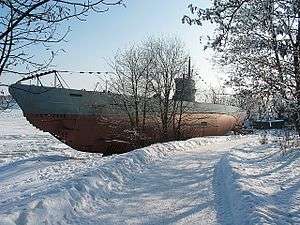Crichton-Vulcan

Crichton-Vulcan is an abandoned shipyard in Turku, Finland, that once formed the cornerstone of the Finnish shipbuilding industry. The shipyard is best known for World War II coastal defence ships and submarines it produced.
Shipbuilding at the yard gradually ended after 1976, after a new shipyard had been built in the suburb Perno. The old yard was taken over by Turku Repair Yard and used for ship repair until 2004, when they too moved to the nearby city of Naantali. The shipyard by the Aura River in Turku then lied abandoned some time and was the target of vandalism.[1] However, the site is currently being turned into an upper-class residential area. Demolition of the old buildings began in June 2011.
History

The first shipyard in Turku was established in 1732 on the eastern bank of the Aura River. The first foundry and metal workshop was established in 1842. After the Crimean War the workshop was acquired by William Crichton. Crichton built a new shipyard near the mouth of Aura. Soon a joint-stock company, W:m Crichton & C:o Ab was established, merging smaller shipyards. In 1913 W:m Crichton & C:o Ab went bankrupt, and a new company AB Crichton was established in its place.
Åbo mekaniska verkstads Ab was founded in 1874 and discontinued at the late 1890s. Ab Vulcan was started in 1898 to continue the operations. In 1924 the manager of Vulcan Allan Staffans organised a merger between the two companies creating Crichton-Vulcan Oy. It again was merged with Wärtsilä between 1936 and 1938. Wärtsilä bought the neighbouring boat and engine builder Andros in 1939 and joined it to Crichton-Vulcan. In 1966 the name of the shipyard was changed to Oy Wärtsilä Ab Turun telakka.
Naval ships
During World War I, the shipyard served the Imperial Russian Navy. After Finnish independence in 1917, Finland started a program on naval armament. Most of the ships were designed by the Dutch (German) company Ingenieurskantoor voor Scheepsbouw and built by Crichton-Vulcan.[2]
The shipyard built two coastal defence ships for the Finnish Navy. The 3,900-metric-ton (3,800-long-ton) (displacement) Ilmarinen and Väinämöinen were ordered in 1927 and delivered in 1931 and 1932, respectively.
Submarines

The shipyard also built the prototypes for the World War II German U-boat fleet. Germany was banned under the Treaty of Versailles from building submarines, so work was conducted under foreign dummy companies. Three 716-metric-ton (705-long-ton) submarines were ordered in 1927. The submarines were designed by Ingenieurskantoor voor Scheepsbouw; the design was based on the World War I German Type UB III submarine. The design work and the supervision of the construction was done by Germans. The submarines would serve as a step in the design of the German Type VIIA submarines.[3]
The Vetehinen, the Vesihiisi and the Iku-Turso were commissioned in 1930 and 1931.
A smaller sub, the 250-metric-ton (250-long-ton) Vesikko, was launched in 1933. It too was designed by Ingenieurskantoor voor Scheepsbouw, and was the direct prototype of the German Type II submarine.
Successors

In the mid-1970s, Wärtsilä built a new, larger shipyard in Perno, 8 kilometers (5.0 mi) from the center of Turku. This new shipyard in now operated by Meyer Turku and produces the world's largest cruise ships, the Freedom class and the Oasis class. After 1983 the old shipyard concentrated solely on ship repair; the last newbuilding entirely built at the old shipyard was M/S Rosella, launched in 1979, but until spring 1983 the old shipyard continued to complete ships that were launched at the new yard and then towed to the old yard.
In 1986 Wärtsilä's shipbuilding branch merged with the shipyards of the state-owned Valmet, taking over the Vuosaari shipyard in Helsinki. In 1989 the new company, Wärtsilä Marine, went bankrupt.
A new company, Masa-Yards (now STX Europe), headed by yard manager Martin Saarikangas, took over the new shipyard in Turku and Wärtsilä's Helsinki New Shipyard.
Another new company, Turun Korjaustelakka Oy, now Turku Repair Yard Ltd, was established to take over the old repair yard. In 2004 the old yard was abandoned and the company moved to a new shipyard outside the city limits on Luonnonmaa island in Naantali. The company now operates one of the largest dry docks in the Baltic Sea area used solely for ship repair.[4] It is owned by BLRT Grupp.[5][6][7]
Engines
Wärtsilä, the company, is today one of the leading producers of large diesel engines for ships and power plants,[8] producing Wärtsilä-Sulzer and the Wärtsilä-Vasa engines. The engine factory is also located on the Aura riverbank. In 2004 Wärtsilä decided to move production of its diesel engines from Turku to its factory in Italy.
Ships

A number of ships produced at the old shipyard are still in service, a few examples:
- MV Freewinds, the floating "university" of the Church of Scientology.
- In 1975–76 Wärtsilä delivered five Belorussiya class cruiseferries to the Soviet Union. All of them are still in service.
- Sister ships M/S Turella and M/S Rosella delivered to SF Line for Turku-Stockholm service.
- M/S Bore I delivered to Steamship Company Bore (member of Silja Line) also for Turku-Stockholm service.
See also
- List of vessels built at Crichton-Vulcan and Wärstsilä shipyards in Turku (in Finnish)
- Finnish maritime cluster
- Russian frigate Rurik (1851)
- AG Vulcan
References
- ↑ Modern Ruins in Finland - Turku Repair Yard
- ↑ Finnish Navy in World War II
- ↑ Dutch Export Submarines - Ingenieurskantoor voor Scheepsbouw
- ↑ Turku Repair Yard - company web page
- ↑ "BLRT Grupp, Rohde Nielsen Ink Agreement for Dredger Construction". Dredgingtoday.com. 2011-03-17. Retrieved 2011-07-12.
- ↑ "BLRT Group Expands by Purchasing Shipyard in Finland". SeaNews. 2007-06-07. (subscription required). Retrieved 2011-07-12.
- ↑ Dixon, Gary (2007-06-08). "BLRT in Finnish raid". Trade Winds (NHST Media Group). (subscription required). Retrieved 2011-07-12.
- ↑ Wärtsilä - Group structure